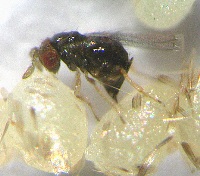|
Skipper
| Symptom of Damage : |
- Removal of leaf tissues and veins and sometimes leaving only the midrib
- Rolling down of leaf tip or folding two edges of the same leaf or two adjacent leaves and tying them with silken threads to make a protective chamber.
- It occurs in the nursery and planted crop.
Nature of Damage :
- The caterpillar folds the leaves and feeds from inside.
- It feeds on the parenchyma leaf and gets reduced to skeleton.
|
 |
 |
| Floating of tubular cases around the tillers |
Papery white leaves |
|
| Top |
| Identification of pest : |
|
Scientific Name - Orseolia oryzae
- Egg : Eggs are laid on the leaves.
- Larva :
The caterpillar is elongate, yellowish green with four white dorsal stripes, smooth with a constructed neck and red ‘V’ mark on the head, which is distinct.
- Pupa :
Pale green pupa has white longitudinal lines on it and is attached to the leaf blade by a silk girdle.
- Adult :
The adult is a dark brown skipper butterfly with two white spots on the wings. |
 |
 |
| Larva |
Adult |
|
|
| Top |
| Management Strategies: |
|
Cultural Methods:
- Flood the nursery to expose the hiding larvae to the surface and thus birds pick them up.
- Kerosenate the water while irrigation to suffocate and kill the larvae.
- Allow the ducks into the field to feed on the larvae.
|
 |
 |
| Allow ducks into the field |
Flood the nursery |
|
|
Chemical Methods:
- Drain the water and spray chlorpyriphos 20 EC 80 ml/ha during late evening.
|
 |
|
| Spray Chlorpyriphos |
|
|
Biological Methods:
- The eggs of rice skippers are parasitized by small wasps. Big wasps and tachinid flies parasitize the larvae. They are preyed upon by reduviid bugs and earwigs. The orb-web spiders feed on the adults during flight.
- Release Trichogramma japonicum (egg parasitoid) on 30 and 37 DAT (twice) and T. chilonis on 37, 44 and 51 DAT (thrice) followed by three sprays of 65 and 72 DAT also reduce the pest.
- Parasites and predators usually control the population density of rice skippers in the field. Release larval parasitoids Apanteles ruficrus, Meteorus sp., Charops bicolor, C. dominans, Drino unisetosa, Pseudoperichaeta orientalis, Strobliomyia aegyptia,Pseudogonia cinerascens, Tachinia fallan, Cuphocera varia, Sturmia inconspicua,Chelonus sp., Euplectrus euplexiae, E. spodopterae.
- Hexamermis sp. a parasitic nematode parasitises the larva.
- Pupa parasitized by Netelia sp., Actia sp., Drino sp. and Isomera cinerascens.
- The vertebrate predators of the larvae are Corvus splendens, C. macrorhynchus, Bubalcus coromandus, Ardeela grayi, Amaurovius phoenicocurus, Acridotheres tristis.
- A nuclear polyhedrosis virus also infects skipper larvae.
|
|
|
 |
 |
| Nuclear polyhedrosis virus |
Trichogramma japonicum |
 |
|
| Tachinid fly parasitize the larvae |
| Top |
|










